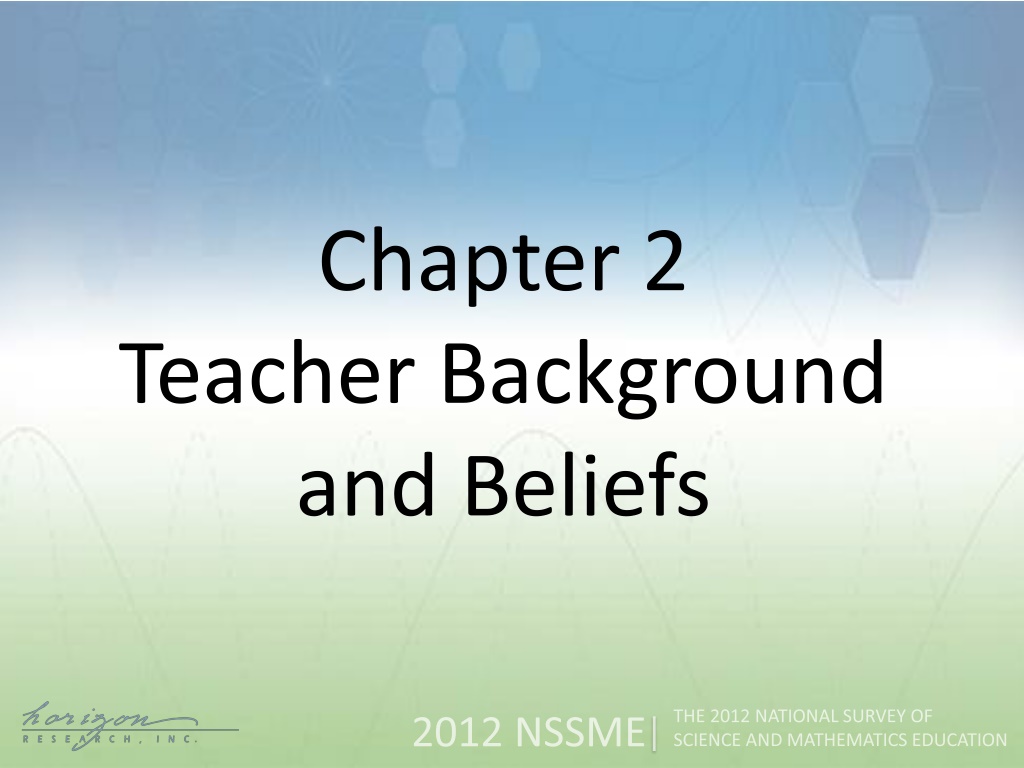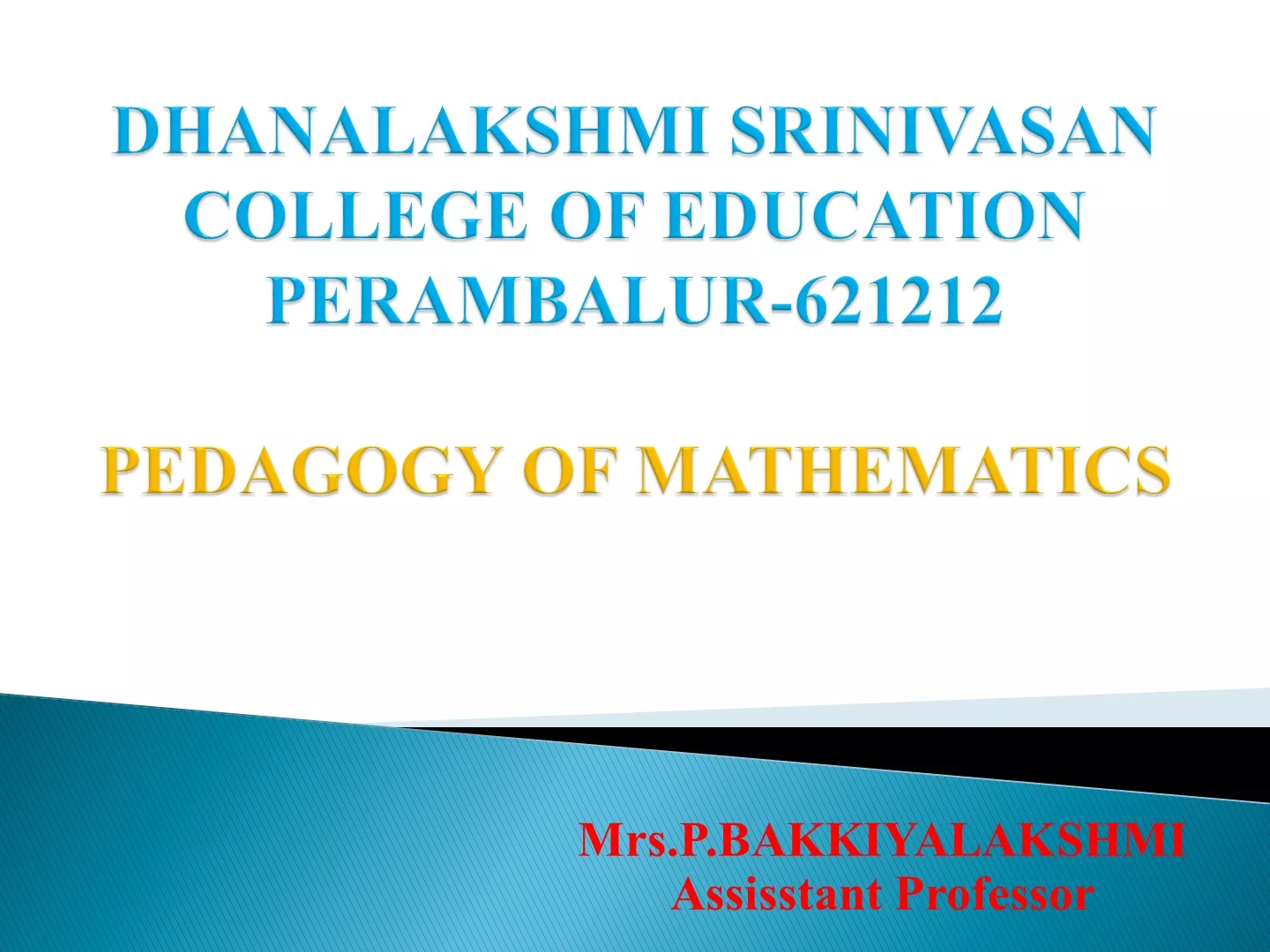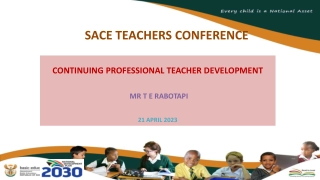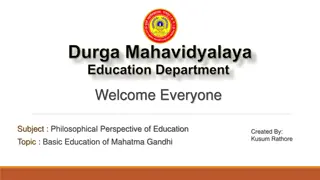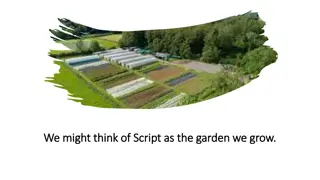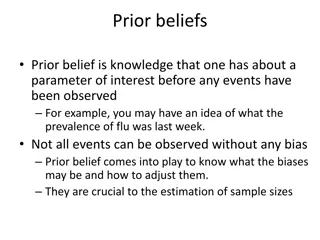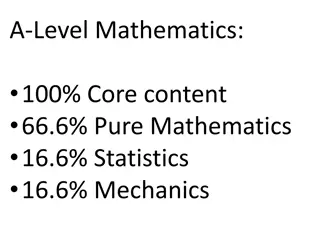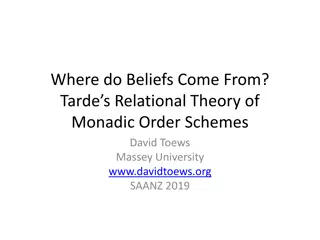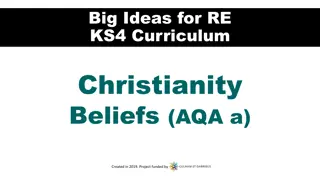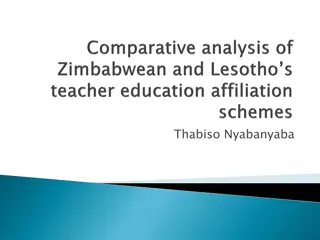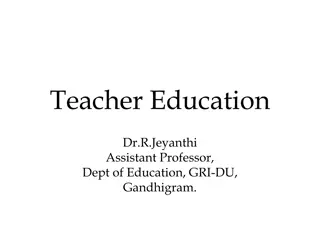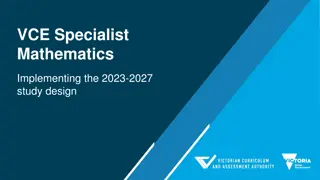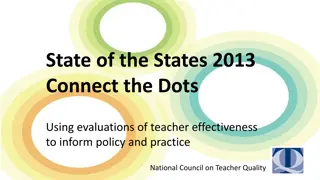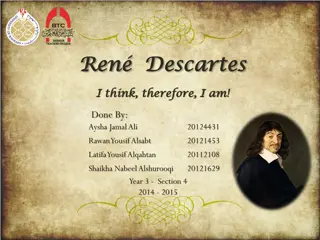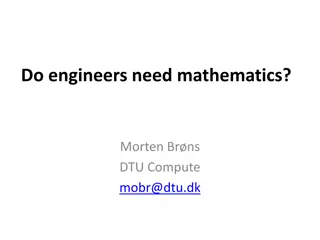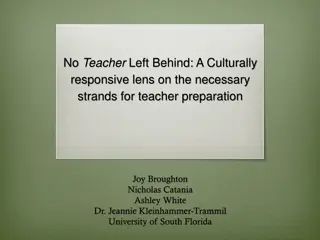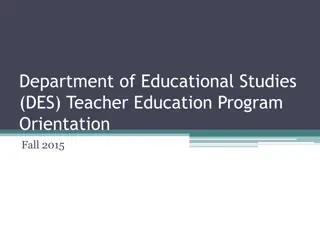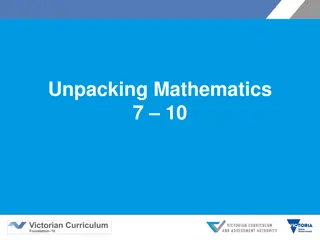Teacher Background and Beliefs in Mathematics Education
This presentation delves into the background characteristics of mathematics teachers, including their age, experience levels, gender distribution, and racial/ethnic demographics across different grade ranges. The data presented sheds light on the diverse profiles of educators within the mathematics teaching force, offering insights into the demographics shaping the field.
Download Presentation

Please find below an Image/Link to download the presentation.
The content on the website is provided AS IS for your information and personal use only. It may not be sold, licensed, or shared on other websites without obtaining consent from the author.If you encounter any issues during the download, it is possible that the publisher has removed the file from their server.
You are allowed to download the files provided on this website for personal or commercial use, subject to the condition that they are used lawfully. All files are the property of their respective owners.
The content on the website is provided AS IS for your information and personal use only. It may not be sold, licensed, or shared on other websites without obtaining consent from the author.
E N D
Presentation Transcript
Chapter 2 Teacher Background and Beliefs
Teacher Characteristics
Original Data for Slides 58 (not for presentation) Table 2.2 Characteristics of the Mathematics Teaching Force, by Grade Range Sex Male Female Race White Black or African-American Hispanic or Latino Asian American Indian/Alaskan Native Native Hawaiian/Other Pacific Islander Two or more races Age 30 31 40 41 50 51 60 61+ Experience Teaching any Subject at the K 12 Level 0 2 years 3 5 years 6 10 years 11 20 years 21 years Experience Teaching Mathematics at the K 12 Level 0 2 years 3 5 years 6 10 years 11 20 years 21 years Experience Teaching at this School, any Subject 0 2 years 3 5 years 6 10 years 11 20 years 21 years Percent of Teachers Middle 24 76 89 6 5 3 1 0 1 18 26 30 21 5 11 15 20 33 21 14 17 25 29 15 23 23 23 23 8 Elementary 8 92 92 4 9 1 1 0 1 17 26 27 24 6 9 13 23 30 24 12 15 22 30 21 20 21 26 22 11 High 44 56 92 3 5 3 1 0 1 17 25 27 20 10 10 13 21 33 23 10 14 22 33 21 21 23 25 23 8 (1.0) (1.0) (1.1) (0.9) (1.3) (0.3) (0.3) (0.3) (0.3) (1.2) (1.4) (1.6) (1.4) (0.9) (1.0) (1.2) (1.3) (1.6) (1.6) (1.1) (1.4) (1.3) (1.6) (1.6) (1.5) (1.4) (1.3) (1.3) (1.2) (1.9) (1.9) (1.3) (0.9) (0.7) (1.0) (0.2) (0.2) (0.3) (1.3) (2.1) (2.2) (1.7) (0.9) (1.2) (1.2) (1.6) (2.1) (1.9) (1.4) (1.3) (1.8) (1.9) (1.6) (1.7) (1.7) (1.8) (2.1) (1.3) (1.7) (1.7) (1.0) (0.6) (0.6) (0.6) (0.4) (0.1) (0.2) (1.2) (1.3) (1.2) (1.1) (1.1) (1.0) (1.1) (1.2) (1.5) (1.2) (0.8) (1.1) (1.3) (1.4) (1.1) (1.3) (1.2) (1.3) (1.3) (0.7)
Mathematics Teacher Sex, by Grade Range 100 92 76 80 Percent of Teachers 56 60 44 40 24 20 8 0 Elementary Middle High Male Female
Mathematics Teacher Race/Ethnicity, by Grade Range 100 92 92 89 80 Percent of Teachers 60 40 20 9 6 5 5 4 3 3 3 1 1 1 1 1 1 1 0 Elementary Middle High American Indian/Alaskan Native Asian Black or African-American Hispanic or Latino White Other
Mathematics Teacher Age, by Grade Range 40 30 Percent of Teachers 27 27 26 26 25 24 21 20 18 20 17 17 10 6 5 0 Elementary Middle High 30 31 40 41 50 51 60 61+
Experience Teaching Mathematics at K 12 Level, by Grade Range 40 33 30 29 Percent of Teachers 25 22 22 21 21 20 17 15 15 14 14 12 10 0 Elementary Middle High 0 2 years 3 5 years 6 10 years 11 20 years 21 years
Original Data for Slide 10 (not for presentation) Table 2.3 Classes Taught by Teachers with Varying Experience Teaching Subject, by Subject and Proportion of Students Eligible for Free/Reduced-Price Lunch Lowest Quartile Experience Teaching Mathematics 0 2 years 12 (2.2) 3 5 years 13 (1.4) 6 10 years 24 (1.9) 11 20 years 30 (2.1) 21 years 22 (2.0) Percent of Classes Second Quartile 12 (1.0) 13 (1.4) 24 (1.7) 32 (2.0) 19 (1.5) Third Quartile 12 16 22 30 21 Highest Quartile 14 19 21 31 15 (1.4) (1.8) (1.8) (1.8) (1.6) (1.6) (1.9) (1.7) (2.1) (1.6)
Classes Taught by Mathematics Teachers with 5 or Fewer Years Experience Teaching Mathematics, by Percentage of Students in School Eligible for Free/Reduced-Price Lunch 100 80 Percent of Classes 60 33 40 28 25 25 20 0 Lowest Poverty Schools Quartile of Schools Based on Percentage of Students Eligible for Free/Reduced-Price Lunch Second Quartile Third Quartile Higest Poverty Schools
Original Data for Slide 12 (not for presentation) Table 2.4 Classes Taught by Non-Asian Minority Teachers, by Subject and Proportion of Non-Asian Minority Students in Class Percent of Classes Mathematics 1 4 12 33 Lowest Quartile of Non-Asian Minority Students Second Quartile of Non-Asian Minority Students Third Quartile of Non-Asian Minority Students Highest Quartile of Non-Asian Minority Students (0.5) (0.7) (1.7) (2.7)
Mathematics Classes Taught by Teachers From Race/Ethnicity Groups Historically Underrepresented in Mathematics, by Percentage of Students in Class from Historically Underrepresented Race/Ethnicity Groups 100 80 Percent of Classes 60 40 33 20 12 4 1 0 Lowest % Underrepresented Quartiles of Classes Based on Percentage of Historically Underrepresented Students in Class Second Quartile Third Quartile Highest % Underrepresented
Teacher Preparation
Original Data for Slide 15 (not for presentation) Table 2.5 Teacher Degrees, by Grade Range Mathematics Teachers Mathematics Mathematics Education Mathematics or Mathematics Education Percent of Teachers Middle 23 26 35 Elementary 4 2 4 High 52 54 73 (0.5) (0.3) (0.6) (1.7) (2.0) (2.2) (1.5) (1.7) (1.7)
Mathematics Teacher Degrees, by Grade Range 100 80 73 Percent of Teachers 54 60 52 35 40 26 23 20 4 4 2 0 Elementary Middle High Mathematics Mathematics Education Mathematics or Mathematics Education
Original Data for Slide 17 (not for presentation) Table 2.6 Secondary Teachers with a Degree in Discipline, by Proportion of Students Eligible for Free/Reduced-Price Lunch Percent of Teachers Second Quartile 53 (2.8) Lowest Quartile 56 Third Quartile 54 Highest Quartile 51 Mathematics Teachers (3.5) (3.1) (3.7)
Secondary Mathematics Teachers with a Degree in Discipline, by Percentage of Students in School Eligible for Free/Reduced-Price Lunch 100 Percent of Teachers 80 56 54 53 60 51 40 20 0 Lowest Poverty Schools Quartile of Schools Based on Percentage of Students Eligible for Free/Reduced-Price Lunch Second Quartile Third Quartile Highest Poverty Schools
Original Data for Slide 19 (not for presentation) Table 2.14 Teachers Completing at Least One Course in Their Field at Two-Year Institutions, by Grade Range Percent of Teachers Middle 28 Mathematics Elementary 35 High 31 (2.5) (2.6) (2.0)
Mathematics Teachers Completing at Least One Course in Their Field at Two-Year Institutions, by Grade Range 100 80 Percent of Teachers 60 35 40 31 28 20 0 Elementary Middle High
Original Data for Slide 21 (not for presentation) Table 2.15 Average Percentage of Courses Teachers Completed in Their Field at Two-Year Institutions, by Grade Range Average Percent of Courses in Field Elementary Middle 48 (1.8) 41 Mathematics Teachers Includes only teachers who completed part of the coursework in their field at a two-year institution. High 30 (3.0) (1.7)
Average Percentage of Courses Mathematics Teachers Completed in Their Field at Two-Year Institutions, by Grade Range 100 Average Percent of Courses in 80 60 Field 48 41 40 30 20 0 Elementary Middle High
Original Data for Slide 23 (not for presentation) Table 2.20 Elementary Mathematics Teachers Completing Various College Courses Mathematics content for elementary school teachers College algebra/trigonometry/elementary functions Computer Science Statistics Integrated mathematics Probability College Geometry Calculus Mathematics education Student teaching in mathematics Percent of Teachers 95 (0.7) 55 (1.6) 50 (2.1) 46 (1.6) 43 (1.7) 24 (1.5) 24 (1.5) 19 (1.4) 95 (0.7) 86 (1.2)
Elementary Mathematics Teachers Completing Various College Courses Mathematics education 95 Mathematics content for elementary teachers 95 Student teaching in mathematics 86 College Algebra/trig./elementary functions 55 Computer science 50 Statistics 46 Integrated mathematics 43 College geometry 24 Probability 24 Calculus 19 0 20 40 60 80 100 Percent of Teachers
Original Data for Slide 25 (not for presentation) Table 2.21 Elementary Mathematics Teachers Coursework Related to NCTM Course-Background Standards All 5 courses 3 4 courses 1 2 courses No courses Percent of Teachers 10 32 57 1 (1.2) (1.6) (1.8) (0.3)
Elementary Mathematics Teachers Coursework Related to NCTM Course-Background Standards 57 60 Percent of Teachers 40 32 20 10 1 0 All 5 courses 3 4 courses 1 2 courses No courses
Original Data for Slides 2730 (not for presentation) Table 2.22 Secondary Mathematics Teachers Completing Various College Courses, by Grade Range Calculus Advanced calculus Differential equations Real analysis Linear algebra Mathematics content for middle/high school teachers Abstract algebra Axiomatic geometry (Euclidean or non-Euclidean) Analytic/Coordinate geometry Integrated mathematics Statistics Probability Number theory Discrete mathematics Other upper division mathematics Computer science Engineering Mathematics education Student teaching in mathematics Percent of Teachers Middle 63 (2.3) 37 (2.1) 22 (1.5) 18 (1.7) 39 (1.9) 56 (2.3) 28 (1.6) 21 (1.6) 26 (1.9) 40 (2.0) 69 (2.1) 39 (2.2) 32 (2.0) 26 (1.7) 19 (1.5) 61 (2.1) 9 (1.2) 87 (1.7) 73 (2.1) High 93 79 62 44 80 71 67 55 53 34 83 56 54 52 43 77 19 87 79 (0.9) (1.6) (1.7) (1.7) (1.7) (1.8) (1.7) (1.7) (1.7) (1.7) (1.5) (1.7) (1.9) (1.8) (1.5) (1.7) (1.4) (1.6) (1.6)
Middle School Mathematics Teachers Completing Various College Courses Mathematics education 87 Student teaching in mathematics 73 Statistics 69 Calculus 63 Computer science 61 Mathematics for middle/high school teachers 56 Integrated mathematics 40 Probability 39 Linear algebra 39 0 20 40 60 80 100 Percent of Teachers
Middle School Mathematics Teachers Completing Various College Courses Advanced calculus 37 Number theory 32 Abstract algebra 28 Analytic/Coordinate geometry 26 Discrete mathematics 26 Differential equations 22 Axiomatic geometry 21 Other upper division mathematics 19 Real analysis 18 Engineering 9 0 20 40 60 80 100 Percent of Teachers
High School Mathematics Teachers Completing Various College Courses Calculus 93 Mathematics education 87 Statistics 83 Linear algebra 80 Student teaching in mathematics 79 Advanced calculus 79 Computer science 77 Mathematics for middle/high school teachers 71 Abstract algebra 67 0 20 40 60 80 100 Percent of Teachers
High School Mathematics Teachers Completing Various College Courses Differential equations 62 Probability 56 Axiomatic geometry 55 Number theory 54 Analytic/Coordinate geometry 53 Discrete mathematics 52 Real analysis 44 Other upper division mathematics 43 Integrated mathematics 34 Engineering 19 0 20 40 60 80 100 Percent of Teachers
Original Data for Slide 32 (not for presentation) Table 2.23 Middle School Mathematics Teachers Coursework Related to NCTM Course-Background Standards Percent of Teachers 14 35 31 15 6 All 6 courses 4 5 courses 2 3 courses 1 course No courses (1.4) (2.0) (2.1) (1.6) (1.0)
Middle School Mathematics Teachers Coursework Related to NCTM Course- Background Standards 60 Percent of Teachers 40 35 31 20 15 14 6 0 All 6 courses 4 5 courses 2 3 courses 1 course No courses
Original Data for Slide 34 (not for presentation) Table 2.24 High School Mathematics Teachers Coursework Related to NCTM Course-Background Standards Percent of Teachers 26 40 22 10 2 All 7 courses 5 6 courses 3 4 courses 1 2 courses No courses (1.5) (1.6) (1.6) (1.4) (0.7)
High School Mathematics Teachers Coursework Related to NCTM Course- Background Standards 60 Percent of Teachers 40 40 26 22 20 10 2 0 All 7 courses 5 6 courses 3 4 courses 1 2 courses No courses
Original Data for Slide 36 (not for presentation) Table 2.25 Teachers Paths to Certification, by Subject and Grade Range Percent of Teachers Middle Elementary High Mathematics An undergraduate program leading to a bachelor s degree and a teaching credential A post-baccalaureate credentialing program (no master s degree awarded) A master s program that also awarded a teaching credential No formal teacher preparation 63 (2.2) 55 (3.1) 48 (2.3) 14 22 1 (1.9) (2.0) (0.4) 17 25 3 (2.1) (2.7) (1.1) 20 22 10 (1.8) (1.6) (1.9)
Mathematics Teachers Path to Certification, by Grade Range 80 63 Percent of Teachers 55 60 48 40 25 22 22 20 17 20 14 10 3 1 0 Elementary Middle High Bachelor's degree w/ teaching credential Post-baccalaureate credentialing program (no master's) Master's program w/ teaching credential No formal teacher preparation
Teacher Pedagogical Beliefs
Original Data for Slides 3944 (not for presentation) Table 2.27 Mathematics Teachers Agreeing with Various Statements about Teaching and Learning, by Grade Range Percent of Teachers Middle Most class periods should provide opportunities for students to share their thinking and reasoning Most class periods should conclude with a summary of the key ideas addressed Most class periods should include some review of previously covered ideas and skills Students should be provided with the purpose for a lesson as it begins Students should be assigned homework most days At the beginning of instruction on a mathematical idea, students should be provided with definitions for new vocabulary that will be used It is better for mathematics instruction to focus on ideas in depth, even if that means covering fewer topics Inadequacies in students mathematics background can be overcome by effective teaching Students learn mathematics best in classes with students of similar abilities Hands-on activities/manipulatives should be used primarily to reinforce a mathematical idea that the students have already learned Teachers should explain an idea to students before having them investigate the idea Includes teachers indicating strongly agree or agree on a 5-point scale ranging from 1 strongly disagree to 5 strongly agree. Elementary High 97 (0.5) 95 (0.8) 93 (0.8) 95 (0.8) 93 (1.0) 90 (0.9) 96 95 (0.6) (0.6) (1.7) 90 92 (1.2) (1.2) (1.9) 87 85 (1.0) (0.9) (1.3) 67 76 82 90 (1.1) 83 (1.5) 81 (1.0) 78 (1.5) 82 (1.8) 78 (1.2) 87 (1.3) 83 (1.6) 77 (1.3) 51 (1.7) 69 (2.2) 77 (1.1) 52 (1.7) 40 (2.1) 39 (1.7) 48 (1.8) 37 (1.8) 38 (1.6)
Elementary School Mathematics Teachers Agreeing with Various Statements about Teaching and Learning Most classes should provide students opportunities to share thinking/reasoning 97 Most class periods should include review 96 Most classes should end with summary of key ideas 95 Students should be provided with a purpose for a lesson 95 Instruction should focus on depth over breadth 78 0 20 40 60 80 100 Percent of Teachers
Elementary School Mathematics Teachers Agreeing with Various Statements about Teaching and Learning Provide defintions for new vocabulary at beginning of instruction on an idea 90 Hands-on should reinforce ideas already learned 52 Students learn best with those of similar abilities 51 Teacher should explain ideas before having students investigate them 48 0 20 40 60 80 100 Percent of Teachers
Middle School Mathematics Teachers Agreeing with Various Statements about Teaching and Learning Most classes should provide students opportunities to share thinking/reasoning 95 Most classes should end with summary of key ideas 93 Students should be provided with a purpose for a lesson 92 Most class periods should include review 90 Instruction should focus on depth over breadth 82 0 20 40 60 80 100 Percent of Teachers
Middle School Mathematics Teachers Agreeing with Various Statements about Teaching and Learning Provide defintions for new vocabulary at beginning of instruction on an idea 83 Students learn best with those of similar abilities 69 Hands-on should reinforce ideas already learned 40 Teachers should explain ideas before having students investigate them 37 0 20 40 60 80 100 Percent of Teachers
High School Mathematics Teachers Agreeing with Various Statements about Teaching and Learning Most classes should provide students opportunities to share thinking/reasoning 93 Most classes should end with summary of key ideas 90 Most class periods should include review 87 Students should be provided with a purpose for a lesson 85 Instruction should focus on depth over breadth 78 0 20 40 60 80 100 Percent of Teachers
High School Mathematics Teachers Agreeing with Various Statements about Teaching and Learning Provide defintions for new vocabulary at beginning of instruction on an idea 81 Students learn best with those of similar abilities 77 Hands-on should reinforce ideas already learned 39 Teachers should explain ideas before having students investigate them 38 0 20 40 60 80 100 Percent of Teachers
Teachers Perception of Preparedness
Original Data for Slide 47 (not for presentation) Table 2.28 Elementary Teachers Perceptions of Their Preparedness to Teach Each Subject Percent of Teachers Somewhat Prepared 2 (0.3) 3 (0.7) 12 (0.9) 15 (1.4) Not Adequately Prepared 0 1 1 2 Fairly Well Prepared 17 19 41 43 Very Well Prepared 81 77 47 39 Reading/Language Arts Mathematics Social Studies Science Includes only teachers assigned to teach all four subjects to a single class of students in grades K 6. (0.1) (0.4) (0.3) (0.5) (0.9) (1.5) (1.5) (1.8) (1.0) (1.7) (1.5) (2.1)
Elementary Teachers Considering Themselves Very Well Prepared to Teach Each Subject 100 81 77 80 Percent of Teachers 60 47 39 40 20 0 Reading/Language Arts Mathematics Social Studies Science
Original Data for Slide 49 (not for presentation) Table 2.30 Elementary Teachers Perceptions of Their Preparedness to Teach Selected Mathematics Topics Percent of Teachers Somewhat Prepared 2 (0.4) 9 (1.1) 10 (1.0) 13 (1.1) Not Adequately Prepared 0 (0.1) 1 (0.4) 3 (0.6) 5 (0.7) Fairly Well Prepared 21 33 33 36 Very Well Prepared 77 56 54 46 Number and Operations Measurement and Data Representation Geometry Early Algebra Includes only teachers assigned to teach mathematics, reading/language arts, science, and social studies to a single class of students in grades K 6. (1.3) (1.9) (1.7) (1.7) (1.4) (2.0) (1.9) (2.0)
Elementary Teachers Considering Themselves Very Well Prepared to Teach Selected Mathematics Subjects 100 77 80 Percent of Teachers 56 60 54 46 40 20 0 Number and Operations Measurement and Data Representation Geometry Early Algebra
Original Data for Slides 5152 (not for presentation) Table 2.32 Secondary Mathematics Teachers Considering Themselves Very Well Prepared to Teach Each of a Number of Topics, by Grade Range Algebraic thinking The number system and operations Functions Measurement Geometry Modeling Statistics and probability Discrete mathematics Percent of Teachers Middle 76 (1.9) 88 (1.4) 60 (1.9) 66 (2.1) 62 (2.0) 49 (2.3) 48 (2.2) 18 (1.5) High 91 90 84 79 70 58 30 25 (0.9) (1.1) (1.5) (1.2) (1.4) (2.0) (1.2) (1.2)
